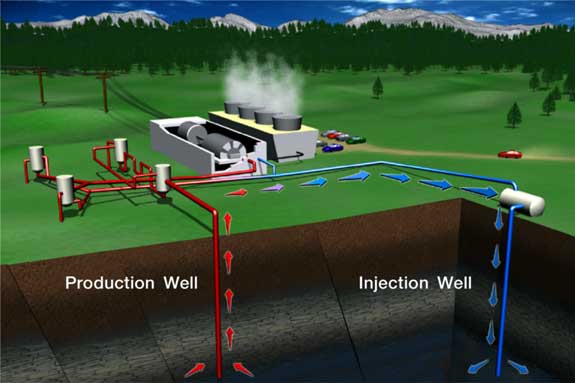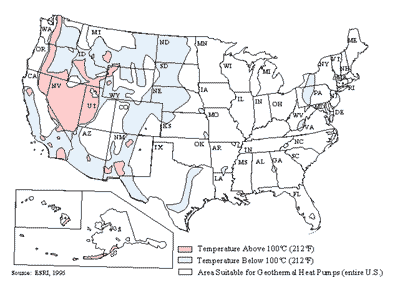Archive for November, 2006
Geothermal financing workshop
I had a fantastic day yesterday soaking up knowledge at the Geothermal Energy Association workshop on financing geothermal projects. This was a business workshop with the morning focused on politics, regulation, and government agencies (note to politicos – less interference would be more here…) and the afternoon dedicated to the attributes required for fundable geothermal projects. The speakers were mostly engaging, the content was rich, and the room was awkwardly laid out, but had windows.
One thing I hadn’t realized (naively) was just how politicized the issue of renewable energy is. That became quite clear at the workshop and the elections last week will help as soon-to-be-Senate majority leader Harry Reid (D-NV) is a geothermal fan (Nevada is rich in geothermal resources.) Hopefully, Congress and the Administration will choose to collaborate on renewable issues extending the production tax credit and making leases of BLM land and NEPA environmental assessments more accessible and faster. I’ll believe that when I see it…
Technorati Tags: Geothermal | Finance | Workshop
Energy conservation is important too…
I am delighted to see this joint program between Sun and PG&E:
Sun Announces First-of-its-Kind Energy Rebate With PG&E
Space, power, cooling and budget are the growing constraints for every datacenter. In August of this year, Sun announced a first-of-its-kind energy rebate for its Sun Fire T1000 and T2000 servers with California utility PG&E. As part of PG&E’s Non Residential Retrofit program, customers replacing existing equipment with these eco responsible servers can receive a cash savings between $700-$1000 per server or up to 35 percent when combined with the Sun Upgrade Advantage Program(3). This is the first time a public utility company has offered a rebate for server upgrades, helping customers move to more efficient technology and easing their datacenter constraints.
Not only that, the Tx000 series servers consume far less power than competing systems and provide many times the performance on multi-threaded work loads, what’s not to like? Kudos to PG&E and Sun, you’re making a difference.
Technorati Tags: Energy | Rebate | Server
Hot dry rock or enhanced geothermal system?
Yesterday I had the pleasure to meet with a geologist who possesses vast knowledge of the geothermal landscape (literally.) One item that came up in our conversation was about the blog entry I wrote concerning geothermal power, and in particular “hot dry rock.”
The geologist indicated that HDR has been around for awhile with the initial work being pioneered in 1970 at the Fenton Hill site in Los Alamos, NM. Apparently the folks in Australia are at the same point the New Mexico crowd reached, they found hot dry rock, they were able to fracture it, but then the injection of fluids became something of an adventure. One doesn’t really know what will happen to the fluid injected into the system, sometimes it comes out the production wells and sometimes it doesn’t. No one really knows how to overcome that problem, though as the geologist noted, the Aussies seem very optimistic.
Enhanced geothermal systems (EGS) is the new HDR, at least here in the US. The idea behind EGS is to use similar approaches that the oil & gas folks use to “enhance” production by attempting to stimulate activity on the edges of a known resource with fluid injection. It has been demonstrated that geothermal systems can be stimulated simply by putting geothermal wells into production. There is a site in California where hot springs proximate to a production field were affected, not by drying up or cooling down, but by heating up!
It’s always valuable to chat with the experts, it’s very clear there’s a huge amount to learn in this area as well as huge opportunity.
Technorati Tags: Energy | Geothermal | Enhanced Geothermal Systems
Electricity from hot water
That’s right, geothermal resources (hot fluid and/or gas) can and is being used to generate electricity the world over. Geothermal literally means “heat from the earth.” The first successful geothermal electricity generation installation was in Larderello, Italy in 1904. The largest is the Geysers in Northern California where 21 plants generate around 3% of California’s electricity.
Geothermal resources can also be used for heating, cooling, and industrial pursuits by circulating the resource through chillers, heat exchangers, etc. This type of use mitigates the need to spend so much other energy in those processes and allows for the use of temperate (<75C) geothermal fluids. Beneath the crust of the earth is a large convection circulated body of magma. In weaker and thinner areas of the earth's crust (typically faults) heat from the magma in the mantle is transferred to rocks in the crust and then in turn to water in proximity to the rocks which creates the geothermal resources.

When generating power from geothermal resources, the resource needs to be rather hot >110C. There are 3 methods of tapping the resource: direct dry steam (rare,) direct flash steam (more common,) and binary (increasingly common.) Dry steam is used where the geothermal resources are extremely hot transforming the liquid in the geothermal well directly to gas which then is directed through a separation process to weed out non-steam (rocks, minerals) then routed into a turbine which generates power. The steam is then cooled back into liquid form and then typically reinjected into the geothermal field through an injection well.
Flash steam also requires a very hot resource, though cooler than dry steam, which follows the same process generally as dry steam with an extra step of routing the resource from the production well into a lower pressure area which allows the super-heated liquid to “flash” into steam (this may be repeated a series of times to gather the most steam possible at different pressures) before the resource is cooled and reinjected into the geothermal field.
Perhaps the most interesting and useful of the conversion technologies is the binary plant which uses a series of heat exchangers to transfer the geothermal fluid’s heat energy to a working fluid in a closed system. Typically, the working fluid has a boiling point that is less than that of water (~75C) which is then converted to steam and run through the turbine system, cooled, and recirculated through the system. In this way, the geothermal resource is never in direct contact with the turbine which extends the lifetime and reduces the maintenance associated with the system. The lower operating temperature makes a number of geothermal resources feasible that wouldn’t work with either dry or flash steam approaches.
NREL estimates that with current technology there is around 80GW of geothermal production potential in the US alone. Currently, 2.2GW is in production, primarily in California, Nevada, Utah, and Hawaii.

Another promising, though early development technology is called “hot dry rock” which is being pioneered in Australia. The theory here is to find an area of heat exchange in the crust that lacks water, boring into it, then injecting water to create a man-made geothermal resource.
Properly managed, geothermal is the most cost effective, least polluting, and most predictable of all the renewable energy sources. Disadvantages of the geothermal approach are primarily cost related, it costs around $2.5M/MW at scale to locate an appropriate site, establish the infrastructure, connect to the grid, and begin operations. But the advantages are truly amazing, virtually no emissions from the technology, 90% capacity factor, saleable by products from the dissolved solids (typically silica and zinc,) relatively small plants, and very predictable output. Areas like the Geysers have seen reduced production as the geothermal resource has been removed at a rate greater than natural (and later human assisted) replenishment. That’s where proper resource management comes into play.
Of all the renewable technologies, geothermal has the best chance to compete at scale with traditional fossil fuel plants on the basis of cost, predictability, and reliability.
Technorati Tags: Energy | Geothermal | Electricity
Biomass for the masses
A few months ago I posted an entry about biodiesel fuel which is a great example of biomass at work. A plant undergoing a process to transform it into a fuel for use (biorefining) in our current infrastructure, in this case, transportation.
That’s a great specific case, but biomass is, when you get right down to it, harnessing the power of photosynthesis. Biomass can be easily characterized as biofuels (biodiesel and ethanol,) biopower (typically burning plant waste to generate electricity,) and bioproducts (converting plants into chemicals that replace petroleum products.)
As is true with most renewable technologies, biomass has been around forever. While you might not really think of it this way, a wood fueled fire providing heat really is biomass at work.
Advantages to biomass include the fact that the fuel stock is renewable, plentiful, and generally neutral in CO2 emissions. We certainly know how to grow things very effectively. Disadvantages include particulate emissions from oxidation and farming related issues – water usage and pollution through fertilizers and insectacides. Also, each square meter of ground dedicated to biomass may be a square meter taken out of food production.
Garden variety soybean field (a prominant source of biofuels.)

Like wind and solar, biomass has it’s place in the renewable portfolio and has the potential, particularly in the transportation sector, to move us toward energy independence from fossil fuels.
Technorati Tags: Energy | Renewable | Biomass








